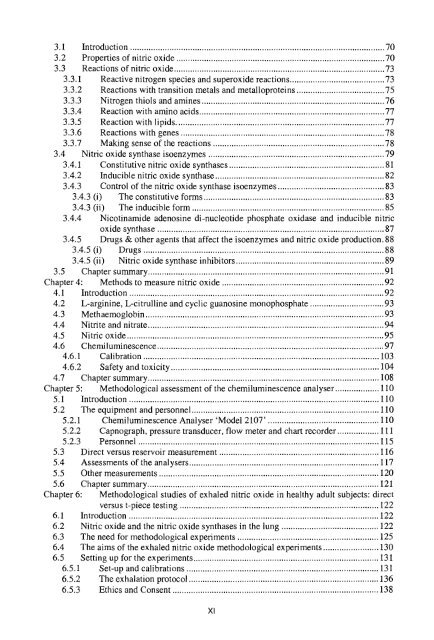http://researchspace.auckland.ac.nz ResearchSpace@Auckland ...
http://researchspace.auckland.ac.nz ResearchSpace@Auckland ...
http://researchspace.auckland.ac.nz ResearchSpace@Auckland ...
Create successful ePaper yourself
Turn your PDF publications into a flip-book with our unique Google optimized e-Paper software.
3.1 Introduction............... .....70<br />
3.2 Properties of nitric oxide ..................70<br />
3.3 Re<strong>ac</strong>tions of nitric oxide......... ..........73<br />
3.3.1 Re<strong>ac</strong>tive nitrogen species and superoxide re<strong>ac</strong>tions.............. ,........73<br />
3.3.2 Re<strong>ac</strong>tions with transition metars ind metalroproteins ....................75<br />
3.3.3 Nitrogen thiols and amines .......76<br />
3.3.4 Re<strong>ac</strong>tion with amino <strong>ac</strong>ids......... ..........,......77<br />
3.3.5 Re<strong>ac</strong>tion with lipids. ..........,......77<br />
3.3.6 Re<strong>ac</strong>tions with genes ................7g<br />
3.3.7 Making sense of the re<strong>ac</strong>tions ....................7g<br />
3.4 Nitric oxide synthase isoe<strong>nz</strong>ymes ............... .......7g<br />
3.4.1 Constitutive nitric oxide synthases .............g1<br />
3.4.2 Inducible nitric oxide synthase.... ...............g2<br />
3.4.3 Control of the nitric oxide synthase isoen2ymes................ ............g3<br />
3.4.3 (i) The constitutive forms ......g3<br />
3.4.3 (ii) The inducible form ...........85<br />
3.4.4 Nicotinamide adenosine di-nucleotide phosphate oxidase and inducible nitric<br />
oxide synthase ........g7<br />
3'4'5 Drug! & other agents that affect the isoe<strong>nz</strong>ymes and nitric oxide production. gg<br />
3.4.5 (i) Drugs ..............88<br />
3.4.5 (ii) Nitric oxide synthase inhibitors.. ........g9<br />
3.5 Chapter summary... .........91<br />
Chapter 4: Methods to measure nitric oxide ................g2<br />
4.1 Introduction............... .....g2<br />
4.2 L-arginine, L-citrulline and cyclic guanosine monophosphate................................93<br />
4.3 Methaemoglobin....... ......g3<br />
4.4 Nitrite and nitrate. ...........g4<br />
4.5 Nitric oxide........ .............95<br />
4.6 Chemiluminescence... .....g7<br />
4.6.1 Calibration ............103<br />
4.6.2 Safety and toxicity ..................104<br />
_ 4.7 Chapter summary... .......10g<br />
Chapter 5: Methodological assessment of the chemiluminescence ana1yser................... l l0<br />
5.1 Introduction ............... ... I l0<br />
5.2, The equipment and personnel.. ....... I l0<br />
5.2.I Chemiluminescence Analyser ,Model 2107, ............110<br />
5.2.2 Capnograph, pressure transducer, flow meter and chart recorder.................. I I I<br />
5.2.3 Personnel .............. I 15<br />
5.3 Direct versus reseryoir measurement .............. ................... I 16<br />
5.4 Assessments of the analysers... .......117<br />
5.5 Other measurements............ ...........120<br />
_ 5.6 Chapter summary... .......121<br />
Chapter 6: Methodological studies of exhaled nitric oxide in healthy adult subjects: direct<br />
versus t-piece testing ..............122<br />
6.1 Introduction............... ...lLz<br />
6.2 Nitric oxide and the nitric oxide synthases in the lung .......... ..............122<br />
6.3 The need for methodological experiments ............... ..........125<br />
6.4 The aims of the exhaled nitric oxide methodological experiments ...... 130<br />
6.5 Setting up for the experiments........... ...............131<br />
6.5.1 Set-up and calibrations......... ....................131<br />
6.5.2 The exhalation protocol.............. .............. 136<br />
6.5.3 Ethics and Consent................ ...................13g<br />
XI















